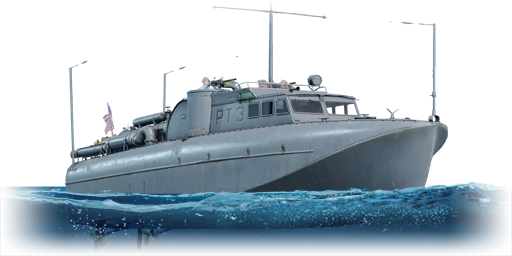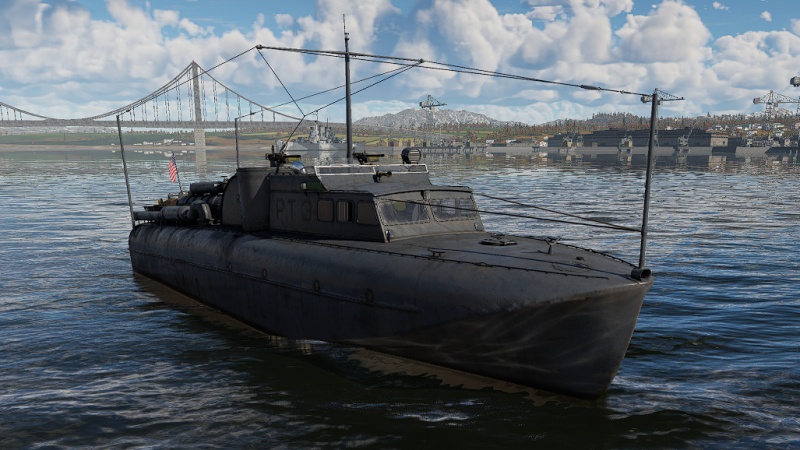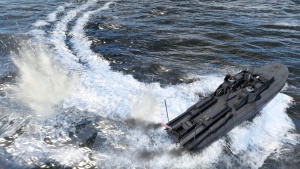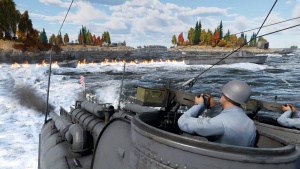Difference between revisions of "PT-3"
CobraKingII (talk | contribs) (→History) |
Jareel_Skaj (talk | contribs) (New description. Added images and external links.) |
||
| (31 intermediate revisions by 9 users not shown) | |||
| Line 1: | Line 1: | ||
| − | {{Specs-Card|code=us_pt3}} | + | {{Specs-Card |
| + | |code=us_pt3 | ||
| + | |images={{Specs-Card-Image|GarageImage_{{PAGENAME}}.jpg}} | ||
| + | }} | ||
== Description == | == Description == | ||
| − | <!--''In the first part of the description, cover the history of the | + | <!-- ''In the first part of the description, cover the history of the ship's creation and military application. In the second part, tell the reader about using this ship in the game. Add a screenshot; if a beginner player has a hard time remembering vehicles by name, a picture will help them identify the ship in question.'' --> |
| − | + | One of a few PT boats surviving to this day, the PT-3 was laid down on 18 April 1940 in Detroit for the United States Navy, Motor Torpedo Boat Squadron 1. In 1942 she was transferred to the Royal Canadian Air Force, designated ''Bras D'Or'' (M 413), serving in the rescue duty for the downed airplane pilots. In 1945 she was transferred to US Navy and stricken from the Naval Vessel Register in 1947. Currently it's stored by the Flanigan Brothers Boatyard in Fairton, New Jersey, undergoing restoration. | |
| − | + | ||
| − | The '''{{ | + | The '''{{Specs|name}}''' was introduced in [[Update 1.83 "Masters of the Sea"]] as part of the release of fleet into open beta test. It is a premium rank {{Specs|rank}} American motor torpedo boat, making it easier to unlock the boats in rank I and early rank II. Featuring a good survivability and a decent weaponry it's a fair competitor against its peers, but it will struggle to survive against any of the higher Battle Rating vessels. |
== General info == | == General info == | ||
=== Survivability and armour === | === Survivability and armour === | ||
| − | ''Talk about the vehicle's armour. Note the most well-defended and most vulnerable zones, e.g. the ammo magazine. Evaluate the composition of components and assemblies responsible for movement and manoeuvrability. Evaluate the survivability of the primary and secondary | + | {{Specs-Fleet-Armour}} |
| + | <!-- ''Talk about the vehicle's armour. Note the most well-defended and most vulnerable zones, e.g. the ammo magazine. Evaluate the composition of components and assemblies responsible for movement and manoeuvrability. Evaluate the survivability of the primary and secondary armaments separately. Don't forget to mention the size of the crew, which plays an important role in fleet mechanics. Save tips on preserving survivability for the "Usage in battles" section. If necessary, use a graphical template to show the most well-protected or most vulnerable points in the armour.'' --> | ||
| + | The PT-3 has no external armour to protect it, and as such cannot sustain much fire before sinking. Its hull is 40 mm of wood, while the superstructure, also made of wood, is 15 mm thick. The most vulnerable sections of the ship are the bridge and the aft section housing the torpedo and depth charge racks as well as the main propulsion system. This is the area that is also the most likely to catch fire as well. When housed, the torpedo and depth charges can be detonated from sustained fire. The 12.7 mm AN-M2 machine guns cannot be knocked out separate to the ship itself. The small crew size of 12 means the PT-3 can take even less of a beating than the [[PT-6]]. | ||
| − | '' | + | === Mobility === |
| + | {{Specs-Fleet-Mobility}} | ||
| + | <!-- ''Write about the ship's mobility. Evaluate its power and manoeuvrability, rudder rerouting speed, stopping speed at full tilt, with its maximum forward and reverse speed.'' --> | ||
| + | [[File:PT-3-manoeuvrability.jpg|thumb|'''PT-3''' can make a very sharp turns, making it possible to escape from tricky situations.]] | ||
| + | {{NavalMobility}} | ||
| − | + | The PT-3 has great mobility, and can achieve a top speed of 63 km/h. When compared to the [[PT-6]], the PT-3 with its shorter length overall can turn much sharper and can navigate narrow waters more easily, however it is slower than PT-6. It takes 19 seconds for the boat to make a complete circle in a turn. From a stop, it accelerates to its top speed of 63 km/h in 13 seconds. From its top speed of 63 km/h, it takes roughly 14 seconds to come to a full stop using the auto stop feature. Compared to other vehicles at its BR, it is slower than the [[LS 3]] and [[G-5]], but is faster than the [[Type T-14]] and the [[MTB-1(1)]]. | |
| − | + | ||
| + | === Modifications and economy === | ||
| + | {{Specs-Economy}} | ||
== Armament == | == Armament == | ||
| + | {{Specs-Fleet-Armaments}} | ||
=== Primary armament === | === Primary armament === | ||
| + | {{Specs-Fleet-Primary}} | ||
| + | <!-- ''Provide information about the characteristics of the primary armament. Evaluate their efficacy in battle based on their reload speed, ballistics and the capacity of their shells. Add a link to the main article about the weapon: <code><nowiki>{{main|Weapon name (calibre)}}</nowiki></code>. Broadly describe the ammunition available for the primary armament, and provide recommendations on how to use it and which ammunition to choose.'' --> | ||
| + | [[File:PT-3-12 7 mm Browning.jpg|thumb|[[AN-M2 (12.7 mm)|AN-M2 Browning]] takes 14.6s to reload, which is slightly faster than on the [[PT-6]]]] | ||
{{main|AN-M2 (12.7 mm)}} | {{main|AN-M2 (12.7 mm)}} | ||
| − | |||
| − | + | The PT-3 is armed with 2 turrets containing a single AN-M2 12.7 mm machine gun located aft of the bridge. They are placed to overlap slightly when firing forward or aft, so as to ensure that all lateral angles can be covered from aircraft and surface threats. They are unable to target aircraft that are flying directly above the ship. The guns are suitable for taking down other similarly sized boats, yet may prove inadequate against more heavily armoured opponents. | |
| + | |||
| + | AP rounds are a good recommendation since they do similar amounts of damage to unarmoured targets as Universal belts. Additionally, using AP means you will have a better chance at penetrating the armour of low tier Soviet boats and sub-chasers. | ||
| + | |||
| + | Three different ammo belts are available: | ||
| + | * '''Universal:''' {{Annotation|API-T|M20 armour-piercing incendiary tracer}}{{-}}{{Annotation|AP|M2 armour-piercing}}{{-}}{{Annotation|I|M1 incendiary}}{{-}}{{Annotation|AP|M2 armour-piercing}} | ||
| + | * '''.50 AP belt:''' {{Annotation|API-T|M20 armour-piercing incendiary tracer}}{{-}}{{Annotation|AP|M2 armour-piercing}}{{-}}{{Annotation|AP|M2 armour-piercing}}{{-}}{{Annotation|AP|M2 armour-piercing}} | ||
| + | * '''.50 APIT belt:''' {{Annotation|API-T|M20 armour-piercing incendiary tracer}}{{-}}{{Annotation|API-T|M20 armour-piercing incendiary tracer}}{{-}}{{Annotation|API-T|M20 armour-piercing incendiary tracer}}{{-}}{{Annotation|I|M1 incendiary}} | ||
| − | + | {{:AN-M2 (12.7 mm)/Ammunition|AP, I, API-T}} | |
| − | {{ | ||
| − | |||
| − | === | + | === Additional armament === |
| − | {{main|Mk.6 depth charge}} | + | {{Specs-Fleet-Additional}} |
| − | + | <!-- ''Describe the available additional armaments of the ship: depth charges, mines, torpedoes. Talk about their positions, available ammunition and launch features such as dead zones of torpedoes. If there is no additional armament, remove this section.'' --> | |
| + | [[File:PT-3-18-inch Mk 7.jpg|thumb|The aft-launched [[18-inch Mk.7 (450 mm)|Mk.7 torpedoes]] are slow and short-ranged, but can sink any coastal vessel with a single hit.]] | ||
| + | {{main|18-inch Mk.7 (450 mm)|Mk.6 depth charge}} | ||
| + | |||
| + | 2 x 450 mm Mk.7 torpedoes are located in tube launchers aft of the ship. They are guided by the direction that the ship is facing. They can be fired while the ship is stationary or reversing and require 50 m to arm before they will detonate. They are powerful enough to sink any ship within the PT-3s BR range, and have a range of 3.65 km. | ||
| + | |||
| + | You can equip 4 x Mk.6 depth charges. They are located at the stern of the boat between the torpedo tubes. | ||
== Usage in battles == | == Usage in battles == | ||
| − | ''Describe the technique of using this ship, the characteristics of her use in a team and tips on strategy. Abstain from writing an entire guide – | + | <!-- ''Describe the technique of using this ship, the characteristics of her use in a team and tips on strategy. Abstain from writing an entire guide – don't try to provide a single point of view, but give the reader food for thought. Talk about the most dangerous opponents for this vehicle and provide recommendations on fighting them. If necessary, note the specifics of playing with this vehicle in various modes (AB, RB, SB).'' --> |
| + | Sitting at the lowest BR it will occasionally fight bigger boats capable of destroying it in a single shot, but fairs pretty well against the other reserve vessels it faces off against. Compared to the PT-6, it has similar armament, yet is slower, and has a lower crew count of 12 sailors, meaning that it cannot take as much punishment as the PT-6 before sinking. In fact, the only advantages this ship has over the PT-6 is its smaller profile and tighter turn radius, making it able to easily navigate restricted waters. | ||
| + | |||
| + | There are 2 ways to play this vehicle. | ||
| + | |||
| + | * Aggressive: Keep the max speed and attempt to manoeuvre through enemy fire as you attempt to get close enough to launch torpedoes. Return fire constantly as you get closer. If you get close enough that you will cross the bow of the enemy ship, launch all depth charges with 5 (or more) second fuse delay to sink it instantly. Be mindful not to hold on to the torpedoes for too long, as they can detonate if hit and sink the ship instantly. During the reload period attempt to spin the ship around and activate smoke to retreat after firing off torpedoes. | ||
| + | * Reserved: This strategy is the preferred method and is more likely to keep you alive. Find a good spot on the map where you can take cover behind and have a clear line of sight on approaching vessels. Launch torpedoes at probable approaches of enemy ships. Slow yourself to a stop behind cover and attempt to point your nose in the direction of incoming enemies so as to use both .50 cals. Try to engage targets at as far away as you can reliably aim, as you do not have the armour to withstand much punishment at close quarters, especially against the German [[LS 3]]. Once you start receiving fire, or during the middle of a lengthy reload, activate your smoke and reverse into the smoke to cover you. Slightly alter your course while reversing to avoid incoming blind fire. Once the smoke has dissipated, your guns should have reloaded and you can fire again, and the smoke discharger should be mostly recharged as well. Try to pick a spot where you can ambush incoming ships, and be sure to wait for supporting allies before attempting to take cap zones. | ||
=== Pros and cons === | === Pros and cons === | ||
| − | '' | + | <!-- ''Summarise and briefly evaluate the vehicle in terms of its characteristics and combat effectiveness. Mark its pros and cons in the bulleted list. Try not to use more than 6 points for each of the characteristics. Avoid using categorical definitions such as "bad", "good" and the like - use substitutions with softer forms such as "inadequate" and "effective".'' --> |
'''Pros:''' | '''Pros:''' | ||
| − | * | + | * Main armament is effective at neutralizing both PT boats and aircraft |
| + | * Large ammo reserves for the primary armament | ||
| + | * Highly manoeuvrable | ||
| + | * Small profile | ||
| + | * Quick acceleration and deceleration | ||
'''Cons:''' | '''Cons:''' | ||
| − | * | + | * Low crew count |
| + | * Unarmoured | ||
| + | * Slow boat | ||
| + | * Machine guns take some time to reload | ||
== History == | == History == | ||
| − | <!-- ''Describe the history of the creation and combat usage of the ship in more detail than in the introduction. If the historical reference turns out to be too | + | <!-- ''Describe the history of the creation and combat usage of the ship in more detail than in the introduction. If the historical reference turns out to be too long, take it to a separate article, taking a link to the article about the ship and adding a block "/History" (example: <nowiki>https://wiki.warthunder.com/(Ship-name)/History</nowiki>) and add a link to it here using the <code>main</code> template. Be sure to reference text and sources by using <code><nowiki><ref></ref></nowiki></code>, as well as adding them at the end of the article with <code><nowiki><references /></nowiki></code>. This section may also include the ship's dev blog entry (if applicable) and the in-game encyclopedia description (under <code><nowiki>=== In-game description ===</nowiki></code>, also if applicable).'' --> |
| − | + | The '''PT-3''' was laid down on August 1, 1939 by Fisher Boat Works in Detroit, Michigan. It was launched on April 18, 1940 and it was completed on June 20 of the same year. It entered service on July 24 and it was assigned to Motor Torpedo Boat Squadron ONE (PTRon 1) to be evaluated. PTRon 1 was the first squadron of its kind, and it was a squadron of experimental ships when it was created and was under the command of Lt. Earl S. Caldwell, USN. | |
| + | |||
| + | It was to be given to the Royal Navy on April 19, 1942 and would have been re-designated as the HM MTB-273. However, the transfer was cancelled and was instead transferred to the Royal Canadian Air Force (RCAF) with the designation Bras D'Or (M 413). It was intended to be used as a high speed rescue launch boat. Following its service in the war, it was was returned to the US on April 10, 1945 and once again re-designated, this time as the B-119. The last transfer in its long and storied history was between the United States Navy (USN) to the War Shipping Administration on May 2, 1946. | ||
| + | |||
| + | It still survives today in rather poor condition and can be found at Flanigan Brothers Boatyard, Fairton, NJ, waiting to be restored. | ||
| + | |||
| + | The ship historically had a displacement of 25 t, a length of 58 ft, and a beam of 18 ft. It was powered by two 1,350 hp Packard gasoline engines, and had two shafts. The armament consisted of two .50 cal machine guns, two 18 inch Mk. 7 torpedoes, and two Mk. 6 depth charge racks. | ||
== Media == | == Media == | ||
| − | '' | + | <!-- ''Excellent additions to the article would be video guides, screenshots from the game, and photos.'' --> |
| + | |||
| + | ;Skins | ||
| + | |||
| + | * [https://live.warthunder.com/feed/camouflages/?vehicle=us_pt3 Skins and camouflages for the {{PAGENAME}} from live.warthunder.com.] | ||
== See also == | == See also == | ||
| − | ''Links to | + | ''Links to articles on the War Thunder Wiki that you think will be useful for the reader, for example:'' |
* ''reference to the series of the ship;'' | * ''reference to the series of the ship;'' | ||
| Line 60: | Line 108: | ||
== External links == | == External links == | ||
| − | ''Paste links to sources and external resources, such as:'' | + | <!-- ''Paste links to sources and external resources, such as:'' |
| + | * ''topic on the official game forum;'' | ||
| + | * ''other literature.'' --> | ||
| + | * [http://shipbuildinghistory.com/shipyards/emergencysmall/fisher.htm <nowiki>[Shipbuilding History]</nowiki> Fisher Boat Works] | ||
| + | * [http://www.flanigan-bros.com/Projects.html <nowiki>[Flanigan Brothers Boatyard]</nowiki> Projects] | ||
| + | |||
| + | === References === | ||
| + | |||
| + | ;Bibliography | ||
| − | * | + | * Radigan, Joseph M. PT-3. NavSource Naval History. http://www.navsource.org/archives/12/05003.htm |
| − | |||
| − | |||
| + | {{ShipManufacturer Fisher Boat Works}} | ||
{{USA boats}} | {{USA boats}} | ||
{{USA premium ships}} | {{USA premium ships}} | ||
Latest revision as of 16:37, 25 January 2024
Contents
Description
One of a few PT boats surviving to this day, the PT-3 was laid down on 18 April 1940 in Detroit for the United States Navy, Motor Torpedo Boat Squadron 1. In 1942 she was transferred to the Royal Canadian Air Force, designated Bras D'Or (M 413), serving in the rescue duty for the downed airplane pilots. In 1945 she was transferred to US Navy and stricken from the Naval Vessel Register in 1947. Currently it's stored by the Flanigan Brothers Boatyard in Fairton, New Jersey, undergoing restoration.
The 58 ft PT-3 was introduced in Update 1.83 "Masters of the Sea" as part of the release of fleet into open beta test. It is a premium rank I American motor torpedo boat, making it easier to unlock the boats in rank I and early rank II. Featuring a good survivability and a decent weaponry it's a fair competitor against its peers, but it will struggle to survive against any of the higher Battle Rating vessels.
General info
Survivability and armour
The PT-3 has no external armour to protect it, and as such cannot sustain much fire before sinking. Its hull is 40 mm of wood, while the superstructure, also made of wood, is 15 mm thick. The most vulnerable sections of the ship are the bridge and the aft section housing the torpedo and depth charge racks as well as the main propulsion system. This is the area that is also the most likely to catch fire as well. When housed, the torpedo and depth charges can be detonated from sustained fire. The 12.7 mm AN-M2 machine guns cannot be knocked out separate to the ship itself. The small crew size of 12 means the PT-3 can take even less of a beating than the PT-6.
Mobility
| Mobility Characteristics | |||
|---|---|---|---|
| Game Mode | Upgrade Status | Maximum Speed (km/h) | |
| Forward | Reverse | ||
| AB | |||
| Upgraded | 88 | 31 | |
| RB/SB | |||
| Upgraded | 63 | 22 | |
The PT-3 has great mobility, and can achieve a top speed of 63 km/h. When compared to the PT-6, the PT-3 with its shorter length overall can turn much sharper and can navigate narrow waters more easily, however it is slower than PT-6. It takes 19 seconds for the boat to make a complete circle in a turn. From a stop, it accelerates to its top speed of 63 km/h in 13 seconds. From its top speed of 63 km/h, it takes roughly 14 seconds to come to a full stop using the auto stop feature. Compared to other vehicles at its BR, it is slower than the LS 3 and G-5, but is faster than the Type T-14 and the MTB-1(1).
Modifications and economy
Armament
Primary armament
The PT-3 is armed with 2 turrets containing a single AN-M2 12.7 mm machine gun located aft of the bridge. They are placed to overlap slightly when firing forward or aft, so as to ensure that all lateral angles can be covered from aircraft and surface threats. They are unable to target aircraft that are flying directly above the ship. The guns are suitable for taking down other similarly sized boats, yet may prove inadequate against more heavily armoured opponents.
AP rounds are a good recommendation since they do similar amounts of damage to unarmoured targets as Universal belts. Additionally, using AP means you will have a better chance at penetrating the armour of low tier Soviet boats and sub-chasers.
Three different ammo belts are available:
- Universal: API-T · AP · I · AP
- .50 AP belt: API-T · AP · AP · AP
- .50 APIT belt: API-T · API-T · API-T · I
| Penetration statistics | |||||||
|---|---|---|---|---|---|---|---|
| Ammunition | Penetration @ 0° Angle of Attack (mm) | ||||||
| 10 m | 100 m | 500 m | 1,000 m | 1,500 m | 2,000 m | ||
| AP | 29 | 28 | 25 | 20 | 17 | 14 | |
| I | 2 | 2 | 2 | 2 | 2 | 2 | |
| API-T | 28 | 27 | 23 | 19 | 15 | 11 | |
| Shell details | ||||||||||||
|---|---|---|---|---|---|---|---|---|---|---|---|---|
| Ammunition | Velocity (m/s) |
Projectile mass (kg) |
Fuse delay (m) |
Fuse sensitivity (mm) |
Explosive mass (TNT equivalent) (g) |
Ricochet | ||||||
| 0% | 50% | 100% | ||||||||||
| AP | 856 | 0.05 | - | - | - | 47° | 56° | 65° | ||||
| I | 944 | 0.04 | 0.02 | 0.3 | 1.2 | 47° | 56° | 65° | ||||
| API-T | 887 | 0.04 | - | - | - | 47° | 56° | 65° | ||||
Additional armament
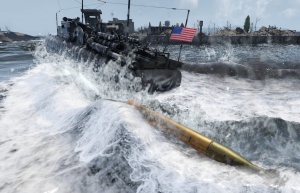
2 x 450 mm Mk.7 torpedoes are located in tube launchers aft of the ship. They are guided by the direction that the ship is facing. They can be fired while the ship is stationary or reversing and require 50 m to arm before they will detonate. They are powerful enough to sink any ship within the PT-3s BR range, and have a range of 3.65 km.
You can equip 4 x Mk.6 depth charges. They are located at the stern of the boat between the torpedo tubes.
Usage in battles
Sitting at the lowest BR it will occasionally fight bigger boats capable of destroying it in a single shot, but fairs pretty well against the other reserve vessels it faces off against. Compared to the PT-6, it has similar armament, yet is slower, and has a lower crew count of 12 sailors, meaning that it cannot take as much punishment as the PT-6 before sinking. In fact, the only advantages this ship has over the PT-6 is its smaller profile and tighter turn radius, making it able to easily navigate restricted waters.
There are 2 ways to play this vehicle.
- Aggressive: Keep the max speed and attempt to manoeuvre through enemy fire as you attempt to get close enough to launch torpedoes. Return fire constantly as you get closer. If you get close enough that you will cross the bow of the enemy ship, launch all depth charges with 5 (or more) second fuse delay to sink it instantly. Be mindful not to hold on to the torpedoes for too long, as they can detonate if hit and sink the ship instantly. During the reload period attempt to spin the ship around and activate smoke to retreat after firing off torpedoes.
- Reserved: This strategy is the preferred method and is more likely to keep you alive. Find a good spot on the map where you can take cover behind and have a clear line of sight on approaching vessels. Launch torpedoes at probable approaches of enemy ships. Slow yourself to a stop behind cover and attempt to point your nose in the direction of incoming enemies so as to use both .50 cals. Try to engage targets at as far away as you can reliably aim, as you do not have the armour to withstand much punishment at close quarters, especially against the German LS 3. Once you start receiving fire, or during the middle of a lengthy reload, activate your smoke and reverse into the smoke to cover you. Slightly alter your course while reversing to avoid incoming blind fire. Once the smoke has dissipated, your guns should have reloaded and you can fire again, and the smoke discharger should be mostly recharged as well. Try to pick a spot where you can ambush incoming ships, and be sure to wait for supporting allies before attempting to take cap zones.
Pros and cons
Pros:
- Main armament is effective at neutralizing both PT boats and aircraft
- Large ammo reserves for the primary armament
- Highly manoeuvrable
- Small profile
- Quick acceleration and deceleration
Cons:
- Low crew count
- Unarmoured
- Slow boat
- Machine guns take some time to reload
History
The PT-3 was laid down on August 1, 1939 by Fisher Boat Works in Detroit, Michigan. It was launched on April 18, 1940 and it was completed on June 20 of the same year. It entered service on July 24 and it was assigned to Motor Torpedo Boat Squadron ONE (PTRon 1) to be evaluated. PTRon 1 was the first squadron of its kind, and it was a squadron of experimental ships when it was created and was under the command of Lt. Earl S. Caldwell, USN.
It was to be given to the Royal Navy on April 19, 1942 and would have been re-designated as the HM MTB-273. However, the transfer was cancelled and was instead transferred to the Royal Canadian Air Force (RCAF) with the designation Bras D'Or (M 413). It was intended to be used as a high speed rescue launch boat. Following its service in the war, it was was returned to the US on April 10, 1945 and once again re-designated, this time as the B-119. The last transfer in its long and storied history was between the United States Navy (USN) to the War Shipping Administration on May 2, 1946.
It still survives today in rather poor condition and can be found at Flanigan Brothers Boatyard, Fairton, NJ, waiting to be restored.
The ship historically had a displacement of 25 t, a length of 58 ft, and a beam of 18 ft. It was powered by two 1,350 hp Packard gasoline engines, and had two shafts. The armament consisted of two .50 cal machine guns, two 18 inch Mk. 7 torpedoes, and two Mk. 6 depth charge racks.
Media
- Skins
See also
Links to articles on the War Thunder Wiki that you think will be useful for the reader, for example:
- reference to the series of the ship;
- links to approximate analogues of other nations and research trees.
External links
References
- Bibliography
- Radigan, Joseph M. PT-3. NavSource Naval History. http://www.navsource.org/archives/12/05003.htm
| Fisher Boat Works | |
|---|---|
| Motor Torpedo Boats (PT) | |
| 58’ Prototype PT | PT-3 |
| USA boats | |
|---|---|
| Motor torpedo boats | PT-3 · PT-6 · PT-20 · PT-71 · PT-103 · PT-109 · PT-174 |
| PT-200 · PT-314 · Thunderbolt (PT-556) · PT-565 · PT-658 · PT-810 · PT-811 · PT-812 | |
| Motor gun boats | Kim Qui · LCS(L)(3) · PT-59 · PTF-7 · USS Candid · USS Asheville · USS Douglas · USS Flagstaff · USS Tucumcari · USS Cyclone |
| Armoured gun boats | LCM(6) Zippo |
| USA premium ships | |
|---|---|
| Motor torpedo boats | PT-3 · PT-109 · PT-174 · Thunderbolt (PT-556) · PT-658 · PT-811 |
| Motor gun boats | LCM(6) Zippo · USS Douglas · USS Flagstaff |
| Sub-chasers | Carmi (PC-466) |
| Destroyers | USS Welborn C. Wood · USS Wilkinson · USS Bennion · USS Cowell · USS Davis · USS Moffett · USS Phelps · USS Frank Knox |
| Light cruisers | USS Detroit · USS Helena |
| Heavy cruisers | USS Des Moines |
| Battleships | USS Arkansas |


